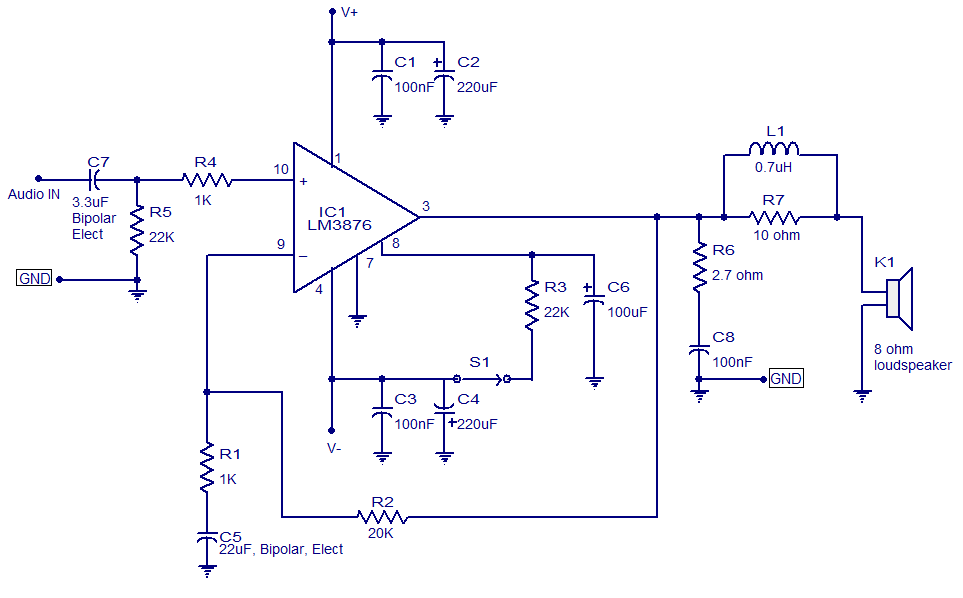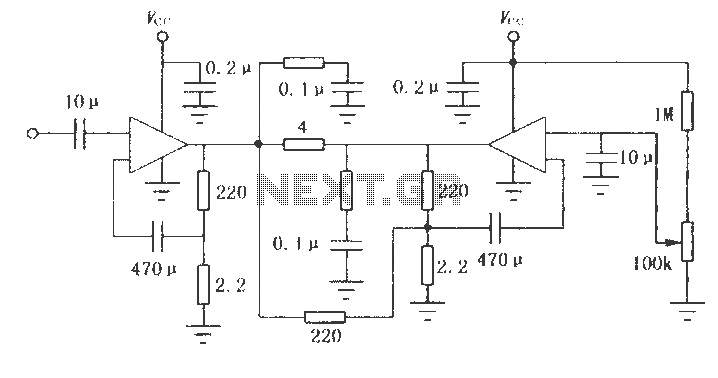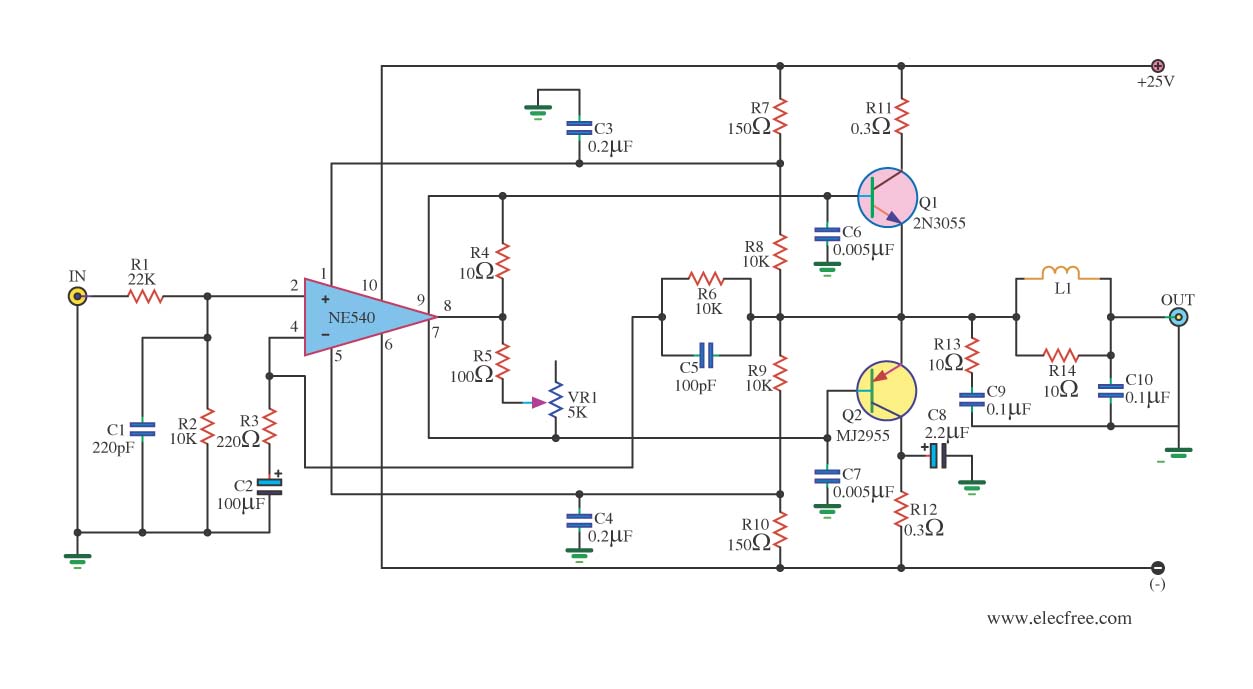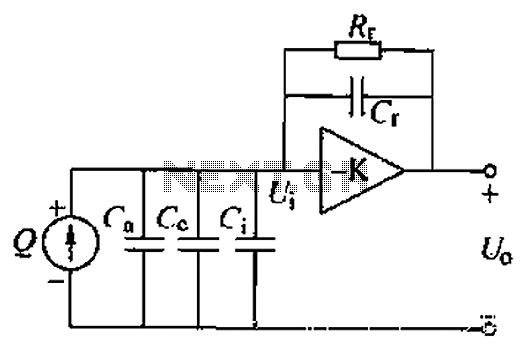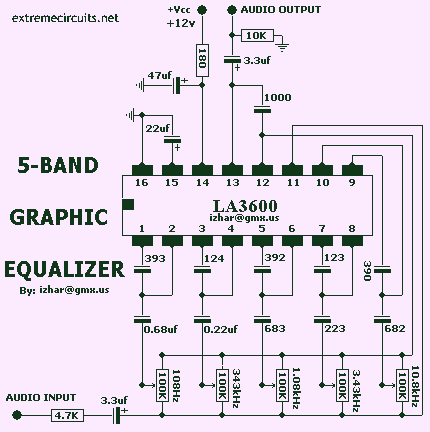
hf 5 band mosfet amplifier
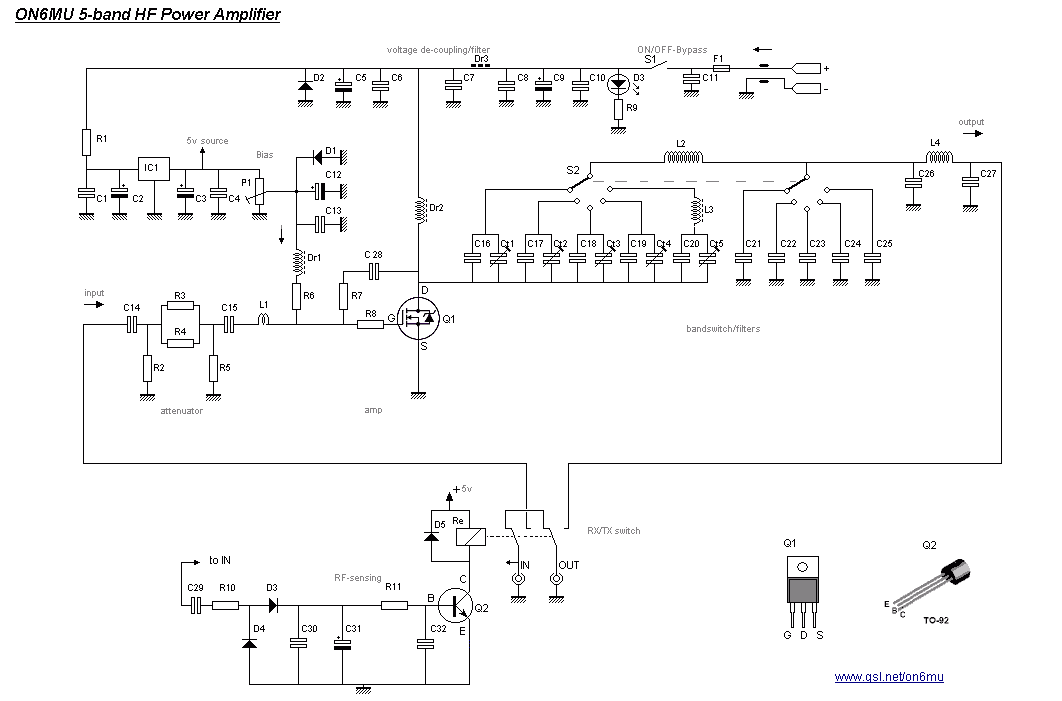
This project utilizes the IRF510 MOSFET, a widely available N-Channel enhancement mode power field effect transistor. It is designed to withstand specified levels of energy in breakdown avalanche mode. Unlike bipolar transistors, which are current-controlled and have lower input impedance, MOSFETs are voltage-controlled devices with very high input impedance at DC. Biasing a MOSFET for linear operation requires only a fixed voltage applied to its gate via a resistor. MOSFETs feature built-in self-regulating actions that prevent thermal runaway and do not require negative feedback for low-frequency gain suppression, which is often necessary with bipolar RF transistors. The choice of the IRF510 is influenced by its popularity among amateur radio operators and cost-effectiveness, despite its slightly lower performance in maintaining constant gain and power output across a wide frequency range. The design incorporates an "old school" radio valve coupling with an L-filter for impedance matching between the output and the antenna, as FET devices share more similarities with vacuum tubes than bipolar transistors. Both vacuum tubes and FETs are controlled by input voltage rather than current and feature three basic terminals: gate, source, and drain, which can be compared to vacuum tube terminals. Key relationships between the two include transconductance and output. An advantage of MOSFETs is the absence of gate leakage current and the lack of need for input and reverse transconductance. The amplifier is designed to be driven by transmitters in the range of 0.5 to 2 watts, with a built-in sensitive T-R relay that switches the unit in and out of the antenna line. In receive mode, the amplifier is bypassed, allowing direct feed from the antenna to the input jack. When transmitting, the T-R circuit detects the RF power and automatically activates the power amplifier to enhance the applied RF power. For "barefoot" operation, turning off the amplifier disables it, allowing QRP operation. The input drive can range from 0.4 watts to 2 watts, amplified to approximately 25 watts, with output varying based on input power and applied voltage. The power output is not perfectly linear across frequency bands, and while a 50-ohm impedance match could be achieved with a 1:4 toroid, the chosen L-filter method aligns with the design philosophy. It is important to note that the IRF510 is not flawless, as lower-grade versions exist that can diminish output power and signal quality. The N-channel MOSFET has relatively high input capacitance and variable output capacitance with crossover frequency, which may pose challenges in maintaining constant gain and power output across various frequency bands. The design aims for simplicity, accommodating one to five bands, albeit with some inherent compromises, resulting in output power fluctuations per band. When driven within the optimal range of +/- 1.5 watts, the amplifier can deliver approximately 25 watts with a tolerance of +/- 10%. For AM transmission, output power should be set to around +/- 50% of the maximum.
The IRF510 MOSFET is a key component in this power amplifier design. Its operation as an N-channel enhancement mode device allows for efficient amplification of RF signals. The high input impedance characteristic of the MOSFET minimizes loading on the preceding stages, thus preserving signal integrity. The biasing method employed ensures that the MOSFET operates within its linear region, which is crucial for maintaining signal fidelity.
The integration of the T-R relay enhances the functionality of the amplifier by providing seamless transition between transmit and receive modes. This relay is sensitive to RF signals, ensuring that the amplifier is engaged only during transmission, thereby preventing unnecessary power consumption and potential damage during reception.
The choice of an L-filter for impedance matching is particularly relevant in RF applications, as it provides a simple yet effective means of ensuring maximum power transfer to the antenna. This method is favored for its ability to minimize reflections and losses that can occur at the interface between the amplifier and the antenna.
The performance limitations associated with the IRF510, particularly regarding frequency response and output linearity, are acknowledged. Careful consideration is given to the design to mitigate these challenges, including potential adjustments to the circuit to optimize performance across multiple bands. The design ethos prioritizes versatility and simplicity, allowing users to operate across various frequency bands while managing the trade-offs inherent in such a configuration.
The overall design of this power amplifier, with its combination of modern MOSFET technology and traditional impedance matching techniques, represents a thoughtful approach to amateur radio amplification, catering to the needs of operators seeking a reliable and effective solution for RF transmission.This project uses a widely available IRF510 MOSFET. This N-Channel enhancement mode silicon gate power field effect transistor is an advanced power MOSFET designed, tested, and guaranteed to withstand a specified level of energy in the breakdown avalanche mode of operation. MOSFETs operate very differently from bipolar transistors. MOSFETs are vol tage-controlled devices and exhibit a very high input impedance at dc, whereas bipolar transistors are current-controlled devices and have a relatively low input impedance. Biasing a MOSFET for linear operation only requires applying a fixed voltage to its gate via a resistor.
The built-in self-regulating actions prevent MOSFETs from being affected by thermal runaway. MOSFETs do not require negative feedback to suppress low-frequency gain as is often required with bipolar RF transistors. I chose the IRF510 because lots of hams use `em and they`re cheap. But they perform a bit less when it comes to constant gain and/or power output across a wide range of frequency bands.
I wasn`t especially concerned with that, and the advantages outweigh the contra`s, so I went with that MOSFET. Rather then using a 1:4 toroid (which is excellent) to match Q1 impedance to 50 Ohms, I have applied the "old school" radio valve coupling; impedance matching circuitry between the output and the antenna using a L-filter.
Why FET devices are more closely related to vacuum tubes than are bipolar transistors (and because I do like to do things my way HI). Both vacuum tubes and the FET are controlled by the voltage level of the input rather then the input current.
They have three basic terminals, the gate, the source and the drain. These are related and can be compared to the vacuum tube terminals. The ralationship between the two doesn`t stop here. The two most important relationships are called the transconductance and output. An advantage of MOSFET devices is that they do not have gate leakage current and MOSFETs do not need input and reverse transconductance. The amplifier is made to be driven by transmitters in the ½ to 2 watt range. Built-in to the power amplifier is a sensitive (Q2) T-R relay which will switch the unit in and out of the antenna line.
When in receive, the amplifier is bypassed and the antenna feeds directly to the input jack, when you go to transmit, the T-R circuit detects the transmit RF power and automatically switches the power amplifier into the circuit and amplifies the applied RF power. If you decide to run "barefoot" turning off the AMP it will disable the amplifier and your QRP The input drive can be anything from 0.
4watt to 2 watt max, which will be amplified to +/- 25 watt. The output varies on the drive power and the applied voltage. The power output is not perfectly linear to the input frequency/band. The impedance 50 Ohms match could be solved by using a 1:4 toroid, or as I like to use, the "old school" radio valve coupling; impedance matching circuitry between the output and the antenna using a L-filter. And, the IRF510 isn`t perfect (note: there are also low grade versions of the Mosfet out there which can lower the output power and influence the quality of the signal/waveform).
The N-channel mosfet has an input capacitance thats a bit on the high side and the output capacitance that varies with the cross over frequency. It can be a slight problem when it comes to constant gain and/or power output across a wide range of frequency bands.
I wasn`t especially concerned with that so I went with this MOSFET anyway. Of course the main issue was the simple design to be able to use one band or even up to five bands if wanted, which always has some compromise in this type of design. This means that there is some fluctuation of the output power par band. When driven between the optimal range of +/- 1. 5 watt the amplifier more then capable to deliver 25 watts +/- 10%. Output power for AM should be set to +/- 50% of max. 🔗 External reference
The IRF510 MOSFET is a key component in this power amplifier design. Its operation as an N-channel enhancement mode device allows for efficient amplification of RF signals. The high input impedance characteristic of the MOSFET minimizes loading on the preceding stages, thus preserving signal integrity. The biasing method employed ensures that the MOSFET operates within its linear region, which is crucial for maintaining signal fidelity.
The integration of the T-R relay enhances the functionality of the amplifier by providing seamless transition between transmit and receive modes. This relay is sensitive to RF signals, ensuring that the amplifier is engaged only during transmission, thereby preventing unnecessary power consumption and potential damage during reception.
The choice of an L-filter for impedance matching is particularly relevant in RF applications, as it provides a simple yet effective means of ensuring maximum power transfer to the antenna. This method is favored for its ability to minimize reflections and losses that can occur at the interface between the amplifier and the antenna.
The performance limitations associated with the IRF510, particularly regarding frequency response and output linearity, are acknowledged. Careful consideration is given to the design to mitigate these challenges, including potential adjustments to the circuit to optimize performance across multiple bands. The design ethos prioritizes versatility and simplicity, allowing users to operate across various frequency bands while managing the trade-offs inherent in such a configuration.
The overall design of this power amplifier, with its combination of modern MOSFET technology and traditional impedance matching techniques, represents a thoughtful approach to amateur radio amplification, catering to the needs of operators seeking a reliable and effective solution for RF transmission.This project uses a widely available IRF510 MOSFET. This N-Channel enhancement mode silicon gate power field effect transistor is an advanced power MOSFET designed, tested, and guaranteed to withstand a specified level of energy in the breakdown avalanche mode of operation. MOSFETs operate very differently from bipolar transistors. MOSFETs are vol tage-controlled devices and exhibit a very high input impedance at dc, whereas bipolar transistors are current-controlled devices and have a relatively low input impedance. Biasing a MOSFET for linear operation only requires applying a fixed voltage to its gate via a resistor.
The built-in self-regulating actions prevent MOSFETs from being affected by thermal runaway. MOSFETs do not require negative feedback to suppress low-frequency gain as is often required with bipolar RF transistors. I chose the IRF510 because lots of hams use `em and they`re cheap. But they perform a bit less when it comes to constant gain and/or power output across a wide range of frequency bands.
I wasn`t especially concerned with that, and the advantages outweigh the contra`s, so I went with that MOSFET. Rather then using a 1:4 toroid (which is excellent) to match Q1 impedance to 50 Ohms, I have applied the "old school" radio valve coupling; impedance matching circuitry between the output and the antenna using a L-filter.
Why FET devices are more closely related to vacuum tubes than are bipolar transistors (and because I do like to do things my way HI). Both vacuum tubes and the FET are controlled by the voltage level of the input rather then the input current.
They have three basic terminals, the gate, the source and the drain. These are related and can be compared to the vacuum tube terminals. The ralationship between the two doesn`t stop here. The two most important relationships are called the transconductance and output. An advantage of MOSFET devices is that they do not have gate leakage current and MOSFETs do not need input and reverse transconductance. The amplifier is made to be driven by transmitters in the ½ to 2 watt range. Built-in to the power amplifier is a sensitive (Q2) T-R relay which will switch the unit in and out of the antenna line.
When in receive, the amplifier is bypassed and the antenna feeds directly to the input jack, when you go to transmit, the T-R circuit detects the transmit RF power and automatically switches the power amplifier into the circuit and amplifies the applied RF power. If you decide to run "barefoot" turning off the AMP it will disable the amplifier and your QRP The input drive can be anything from 0.
4watt to 2 watt max, which will be amplified to +/- 25 watt. The output varies on the drive power and the applied voltage. The power output is not perfectly linear to the input frequency/band. The impedance 50 Ohms match could be solved by using a 1:4 toroid, or as I like to use, the "old school" radio valve coupling; impedance matching circuitry between the output and the antenna using a L-filter. And, the IRF510 isn`t perfect (note: there are also low grade versions of the Mosfet out there which can lower the output power and influence the quality of the signal/waveform).
The N-channel mosfet has an input capacitance thats a bit on the high side and the output capacitance that varies with the cross over frequency. It can be a slight problem when it comes to constant gain and/or power output across a wide range of frequency bands.
I wasn`t especially concerned with that so I went with this MOSFET anyway. Of course the main issue was the simple design to be able to use one band or even up to five bands if wanted, which always has some compromise in this type of design. This means that there is some fluctuation of the output power par band. When driven between the optimal range of +/- 1. 5 watt the amplifier more then capable to deliver 25 watts +/- 10%. Output power for AM should be set to +/- 50% of max. 🔗 External reference
